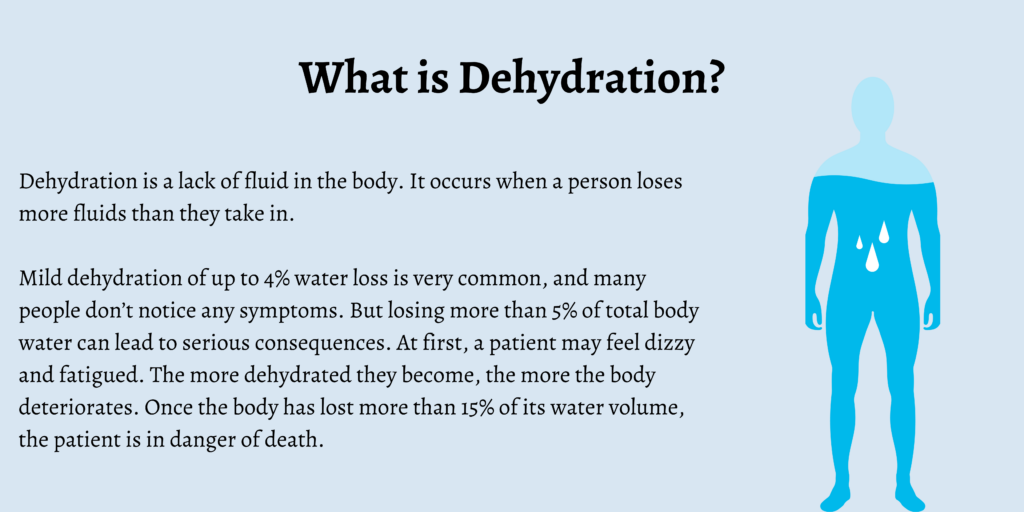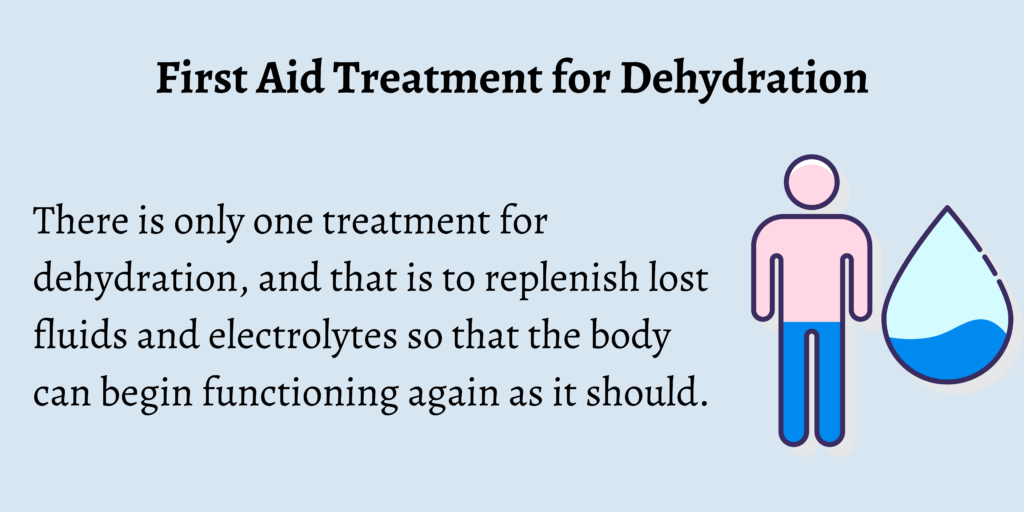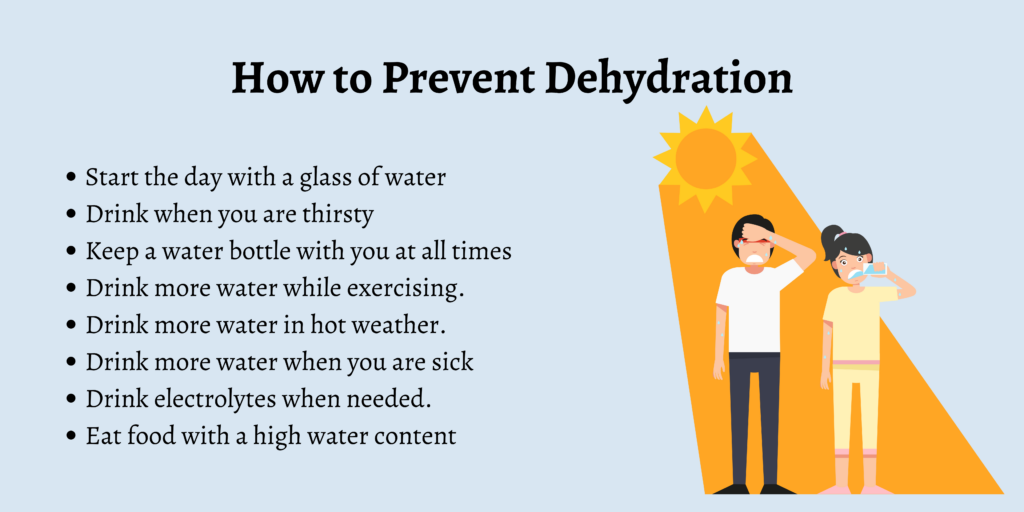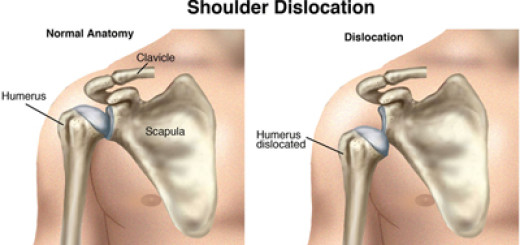First Aid For Dehydration
Dehydration is a potentially serious condition where fluid (and salts) are lost from the body and not adequately replaced. Dehydration ranges in severity from mild to serious, but any level of dehydration is detrimental to the body’s organs.
As a first aider, you are often limited in the interventions you can use to help a patient. But in the case of dehydration, you can personally begin treating the condition right away. So, it’s important that you’re able to recognize the signs and symptoms of dehydration so that you can take action immediately.

What is Dehydration?

Dehydration is a lack of fluid in the body. It occurs when a person loses more fluids than they take in.
Mild dehydration of up to 4% water loss is very common, and many people don’t notice any symptoms. But losing more than 5% of total body water can lead to serious consequences. At first, a patient may feel dizzy and fatigued. The more dehydrated they become, the more the body deteriorates. Once the body has lost more than 15% of its water volume, the patient is in danger of death.
Dehydration is mainly caused by:
- Excessive sweating during physical activity
- Prolonged exposure to the sun or hot conditions
- Sweating because of a fever (high body temperature)
- Severe diarrhea and vomiting
Everyone can become dehydrated if they don’t take in enough fluid, however young children, the elderly, and people involved in prolonged periods of physical activity are particularly at risk.
If untreated, dehydration can lead to heat exhaustion and potentially heat stroke.
The Signs and Symptoms of Dehydration
One of the first signs of dehydration is thirst. The human body constantly monitors its fluid levels, and when those levels get too low, the thirst mechanism triggers the body to drink. But if fluid isn’t replenished, further symptoms arise, and they become more severe the more dehydrated a person becomes.
Recognizing the signs and symptoms of dehydration is crucial as a first aider. Many casualties don’t realize that their symptoms are due to a lack of fluid intake, so being able to confidently identify a patient suffering from dehydration is key.
Here are the main signs and symptoms to look out for:
- Dry mouth, eyes, and other mucous membranes
- Dry, cracked lips
- Headaches, dizziness, and confusion
- Cramp and tightness in muscles, especially in the legs
- A reduction in the amount and frequency of urination.
- Dark-colored, strong-smelling urine
- Extreme thirst
- Sunken eyes
First Aid Treatment for Dehydration

There is only one treatment for dehydration, and that is to replenish lost fluids and electrolytes so that the body can begin functioning again as it should.
But how treatment is provided will depend on the age of a patient, the cause of the dehydration, and the severity of the patient’s condition.
First Aid For Dehydration in Adults
There are some simple first-aid steps you can take if you suspect an adult is suffering from dehydration.
- If the temperature is hot, assist the casualty into a cool, shaded place.
- Encourage them to sit down and stop any physical activity.
- Provide plenty of water or Oral Rehydration Solution (ORS) to drink. ORS helps to replace not only fluids but also essential salts and minerals that may have been lost.
- If the patient is suffering from cramps, stretch and massage the affected muscles.
- Monitor and record vital signs (eg: pulse and respiratory rate) if trained.
- If the casualty remains unwell or deteriorates, seek professional medical attention immediately.
First Aid for Dehydration in Children and Infants
Children and babies are at a higher risk of becoming dehydrated, but spotting the signs can be more difficult. Very young children and infants are not able to articulate their symptoms, so it’s important to look for clues that could point to dehydration.
Provide immediate first aid and seek medical attention if you notice any of the following signs:
- Extreme or unusual sleepiness
- A drop in alertness or responsiveness
- A decrease in wet diapers
- A lack of tears when crying
- Dark-colored, strong-smelling urine in the diaper
- Cold hands and feet
- Blotchy skin
- Sunken eyes and cheeks
- A dry mouth
The most common cause of dehydration in children and infants is sickness, such as fever, diarrhea, and vomiting.
Here are the first aid steps you should take if you suspect an infant is suffering from dehydration.
- If the temperature is hot, move the infant to a cool, shaded place.
- Replace fluids. Infants who are breastfed should be nursed more often. Babies who are formula-fed should be given additional cooled, boiled water either mixed with their regular formula or on its own via a teaspoon or syringe. Focus on giving frequent small sips.
- If possible, provide an Infant Oral Rehydration Solution, such as Pedialyte, to replace fluids and essential salts and minerals that may have been lost.
- Dress the infant in lightweight clothing to cool them down in the case of hot weather or fever.
- Observe their symptoms and monitor and record vital signs (eg: pulse and respiratory rate) if trained. If the infant continues to vomit and lose fluid, or symptoms persist, seek medical attention immediately.
Here are the first aid steps you should take if you suspect a child over the age of 1 is suffering from dehydration.
- If the temperature is hot, take the child to a cool, shaded place.
- Replace fluids. Give the child plenty of water or, if possible, an Oral Rehydration Solution such as Pedialyte, in small, frequent amounts. Ensure they take in several small sips every 15 minutes. Ice chips, ice pops, and clear broths can also be used.
- Dress the child in lightweight clothing to help cool them down in the case of hot weather or fever.
- Observe their symptoms and monitor and record vital signs (eg: pulse / respiratory rate) if trained. If the child continues to vomit and lose fluid, or symptoms persist, seek medical attention immediately.
How to Prevent Dehydration

Dehydration can be life-threatening if left untreated. But it is also a preventable condition.
Here are several ways to avoid becoming dehydrated in the first place.
- Start the day with a glass of water. We are at our most dehydrated first thing in the morning. So, make it a habit to drink a glass of water immediately upon waking to replenish fluids lost throughout the night.
- Drink when you are thirsty. Thirst is our body’s way of telling us it needs more water. So, take a sip whenever thirst cues kick in.
- Keep a water bottle with you at all times. Refill it throughout the day and set yourself hydration goals, eg. finish a full bottle by lunchtime, and another by the end of the working day.
- Drink more water while exercising. When you exercise, your body loses fluid at a much faster rate, so it’s essential to up your intake.
- Drink more water in hot weather. Hot and humid conditions deplete the body’s fluid levels at a much faster rate. Always carry water in these conditions and take plenty of regular sips. Try to stay in cooler shaded areas and avoid prolonged exposure to the sun.
- Drink more water when you are sick. If you have a fever, are vomiting, or have diarrhea, you are at a much higher risk of becoming dehydrated, so keep your fluid intake high. Stick to water, sports drinks, or broth.
- Drink electrolytes when needed. If you have been engaging in vigorous exercise for more than an hour, it’s a good idea to replenish not only fluids but electrolytes too. Sports drinks, coconut water, or electrolyte packets dissolved in water are all good options.
- Eat food with a high water content. We don’t just get our fluids from what we drink. Many of the foods we eat can help us stay hydrated too. Try to eat a diet with plenty of fruits and vegetables. Cucumber, cantaloupe, and watermelon are great options as these foods contain around 90 to 99% water.
Conclusion
Dehydration is a potentially serious condition. So, as a first aider, it’s important to recognize the signs and symptoms. Hopefully, this post will help you to identify a patient suffering from dehydration and give you the confidence to provide effective first-aid treatment.





